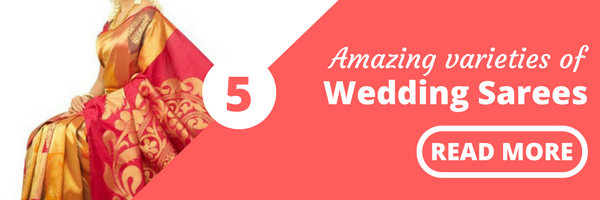Buddhist marriage – Why it is unique?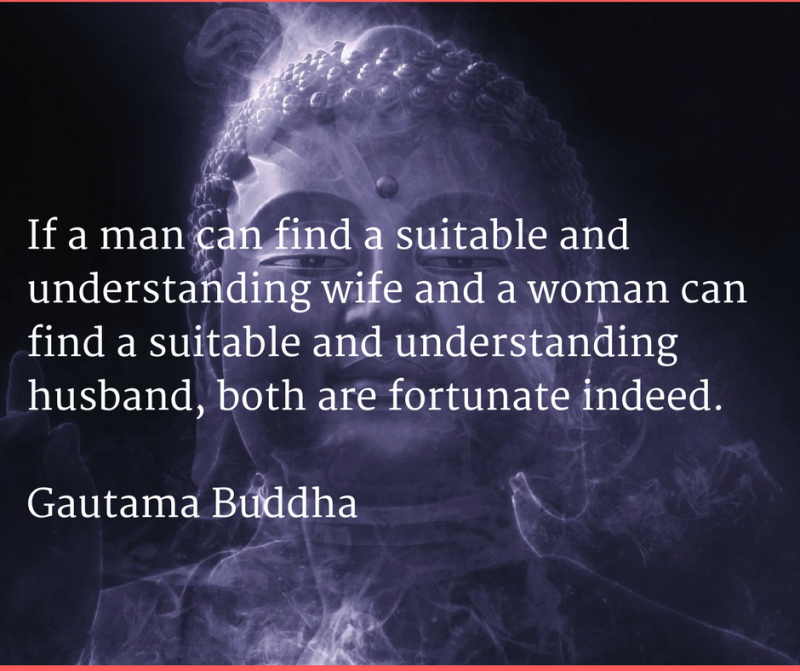
Buddhism originated in India, yet Buddhists constitute a small minority as Hinduism and Islam continue to dominate the subcontinent. Buddhism in India gained significant support as large groups of lower caste Hindus converted from Hinduism to Buddhism in the mid-1950s.
Outside India, Buddhism has taken roots in Japan, South-East Asian countries such as Myanmar, Thailand and South Asian territories such as Bhutan, Tibet, and Sri Lanka.
Buddhist marriage traditions are hence a unique combination of traditional Buddhist rituals along with local customs dictated by geography and culture.
Marriage in Buddhism is not considered a religious affair as it is the case with other religions such as Hinduism, Christianity or Islam.
Gautama Buddha has called out the need to maintain a monogamous lifestyle and the need to avoid adultery. Buddhist monks have also refrained from marriage as they believe marriage brings with it the baggage of commitments and sufferings that could prevent them from serving the world.
Buddhist marriages in India are civil affairs in India devoid of the extensive religious rituals that we find in other wedding ceremonies throughout India. While a Buddhist marriage may be presided over by Buddhist monks, they are very simple and usually happen in front of a portrait of Lord Gautama Buddha and Dr Bheemrao Baba Saheb Ambedkar.
Traditional Buddhist marriages in other parts of the world such as in Thailand, Burma, Sri Lanka, where there is a large Buddhist population, involve a combination of religious rituals blended with local traditions. In fact, Buddhist weddings in South East Asia are divided into Buddhist ceremonies and no-Buddhist ceremonies!
Dr Ambedkar’s influence on Marathi Buddhist marriage traditions
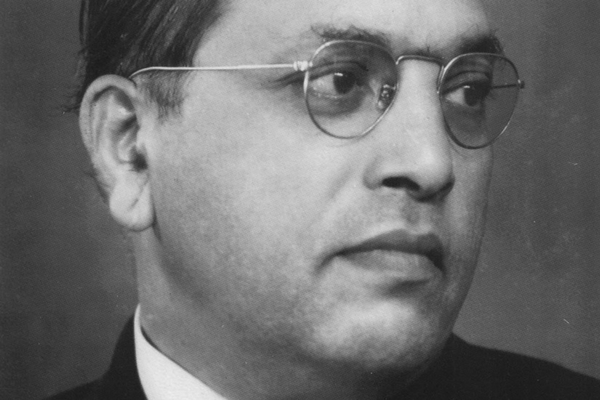
One of the unique aspects of a Buddhist marriage ceremony in India is the enduring presence of Dr Ambedkar’s photograph. Dr Ambedkar is considered to be the spiritual head of Buddhists in India as he was instrumental in helping Dalit communities in India (especially the Mahars) embrace Buddhism as a means to overcome the injustice heaped on them under the caste system practised by the Hindus.
Initially, Dr Ambedkar tried to reform the practice of untouchability and caste system by introducing the revised Hindu Code when he was the law minister in the cabinet of Prime Minister Jawahar Lal Nehru. However, his efforts failed.
Dr Ambedkar quit the government and on 14th October 1956, converted to Buddhism in a formal ceremony in Nagpur. About 400,000 followers also converted to Buddhism and thus set the ball rolling for the revival of Buddhism in India which had all but disappeared from the land of its birth. He coined the word “Navayan” to denote a new path that gave his followers an option to steer clear of the differences in the Hinayana and the Mahayana forms of Buddhism.
Hence, Buddhist marriages in India are closely tied to Dr Ambedkar’s revolutionary decision to convert from Hinduism to Buddhism. That’s not all. Buddhist marriage traditions are also an amalgamation of Hindu traditions as well as regional wedding traditions.
Check out this Buddhist wedding video to see how Buddhists of Maharashtra conduct their wedding ceremony.
The Buddhist marriage biodata
Like other communities, Buddhists in India go through the arranged marriage process. When the son or daughter in the household reaches what parents consider to be a marriageable age, a marriage biodata is created. The Buddhist marriage biodata is similar to the marriage biodata created by Hindus. However, there are a couple of differences:
1. Descendents of people who were supported of Dr Ambedkar consider him to be their Buddha and hence instead of “OM”, a symbol of Ganesha, “Jai Mata Di” that you will find in Hindu marriage biodata, Marathi Buddhists in India include the phrase “Jai Bhim” in their marriage biodata.
2. Another important difference you will notice in Buddhist biodata for marriage formats is the absence of caste and sect. This practice is as a result of Dr Ambedkar’s untiring efforts to free the untouchable Hindu communities from the oppression they endured because of the caste system.
Just as we have in some of the traditional Hindu marriages, horoscope matching is an important criterion for shortlisting matches among the Buddhists. However, creating a marriage biodata continues to be a unique tradition that is limited to South Asian countries.
A modern interpretation of the Buddhist marriage biodata
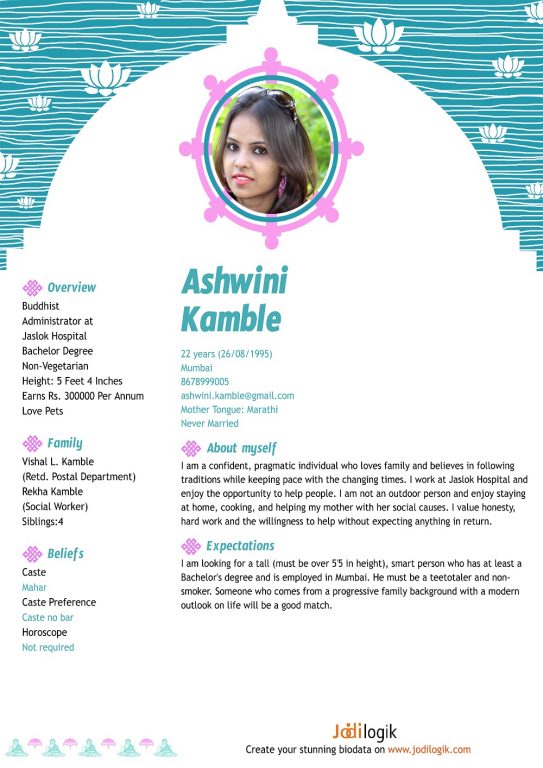
We decided to give a modern spin to the Buddhist marriage biodata. Our 1-page biodata template is inspired by the Sachi Stupa. The dome of the Sanchi Stupa forms the header of the marriage biodata template.
The profile photograph is embedded within the Bhavachakra or the wheel of life. The different sections of the biodata are visually marked by the icon of the endless knot which symbolises the unity of everything.
The footer of the biodata template has the image of Lord Buddha along with the jewelled parasol.
This biodata template is available on sale for a small one-time fee on Jodilogik. Click here to download your copy.
Buddhist marriage sites
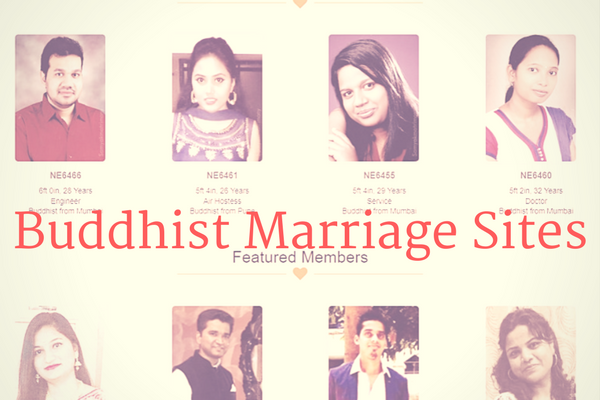 From the perspective of arranged Buddhist marriages in India, Buddhists use matchmaking sites such as Bharat Matrimony, Shaadi, Jeevan Sathi to look for suitable matches. In addition, sites like Navayan.com have a matrimonial section as well that provides free online matchmaking services.
From the perspective of arranged Buddhist marriages in India, Buddhists use matchmaking sites such as Bharat Matrimony, Shaadi, Jeevan Sathi to look for suitable matches. In addition, sites like Navayan.com have a matrimonial section as well that provides free online matchmaking services.
There are commercial sites as well such as Bodhimatri.com, Lagnachibolni and Samyak Matrimony provide exclusive matchmaking services to Buddhists of India.
In addition to matrimonial sites, there are several Buddhist marriage bureaus in large cities of Maharashtra such as Mumbai, Pune and Nagpur that offer matchmaking for the local Buddhist population.
Other Buddhist cultures have their own ways of finding matches and may not necessarily involve the traditional Indian arranged marriage process.
Buddhist marriage invitation card
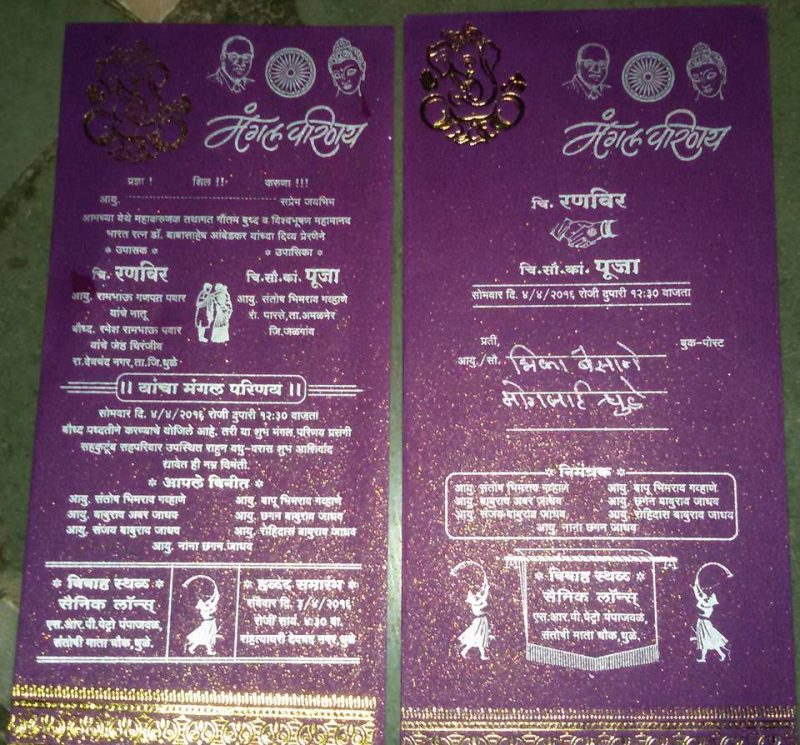
The image above is a sample Buddhist marriage invitation card printed in the Marathi language.
Here are some of the unique characteristics of the Buddhist marriage invitation card:
1. Notice the pictures of Buddha and Dr Ambedkar. Traditional Hindu wedding invitation cards have a Swastika or a symbol of Lord Ganesh.
2. You will also notice that the Ganesh symbol on the Buddhist card. The Ganesh symbol sometimes transcends religious boundaries. In addition, Hindus who converted to Buddhism have brought with them traditions and symbols that are unique to Indian Buddhists.
3. The influence of Marathi culture is also evident not only through the use of Marathi language but also through the icons that depict trumpets used in traditional Marathi weddings from history.
Buddhist wedding invitations in other countries do not have religious imagery and instead are aligned with the local traditions and cultural symbols.
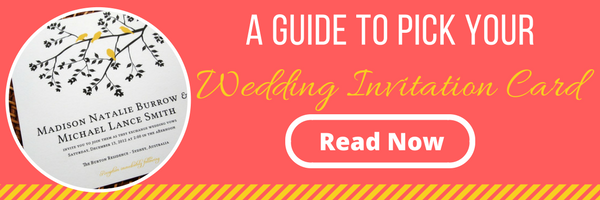
The Buddhist wedding ceremony explained
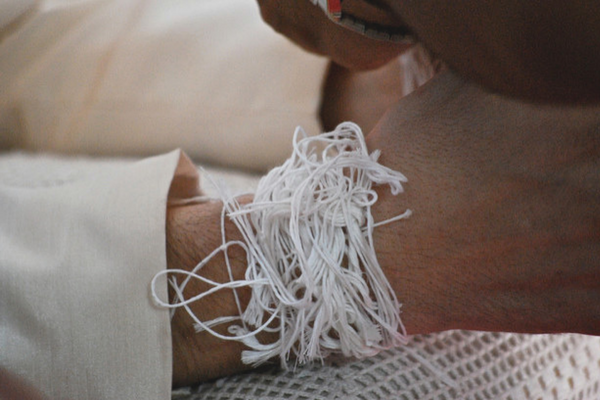
The Buddhist wedding ceremony is not as elaborate as some of the traditional Hindu ceremonies. Once again there are variations in Buddhist marriage rituals based on culture.
Buddhist wedding ceremonies are simple affairs. However, some Marathi Buddhist weddings maybe a little more elaborate because of the influence of local culture and Hindu traditions pertaining to the region. Some of the key highlights of a Buddhist wedding ceremony include:
The formal engagement ceremony is called Chessian and is fixed on an auspicious day. The groom’s family visits the bride’s family and a simple ceremony is organised with the Buddhist monk reciting prayers. In traditional Buddhist societies such as those in South East Asia, a sacred drink called Madyan is distributed among the guests attending the Chessian.
Tribal Buddhists of Tibet, such as the Tamang, exchange Pong (wine) and hens exchange hens as gifts from the bridegroom’s family to the bride’s family.
The engagement ceremony in Marathi Buddhist weddings are aligned to the Hindu weddings customs and involve the exchange of coconuts, beetle leaves and nuts, traditional Marathi sweets, flowers and gifts.
The wedding ceremony itself has different variations depending on geography and culture.
The wedding rituals followed by South Asian Buddhists are distinct although certain components of the rituals are practised irrespective of the region.
Some of the common elements include Buddhist prayers in front of a portrait or idol of Lord Buddha with the couple lighting candles and incense. Dowry is also an accepted practice although, in countries such as Thailand, the dowry is given by the groom to the bride and is considered a symbolic gift only to be returned.
Of course, in India, dowry is illegal, but depending on the social status of the couple’s families, exchange of valuable gifts are the norm.
The parents of the bride and the groom place loops of thread on the heads of the bride and the groom. This ritual is supposed to indicate a connection between the man and the woman or an eternal bond.
The lamas or the monks similarly hold a string of thread with one end of the thread immersed in water. Sacred prayers in Pali language are recited and the monks then apply a paste made out of the water with the string and the wax from the candles. The paste is applied to the foreheads of the bride and the groom as a mark of blessings.
In Marathi Buddhist weddings, the thread ceremony similar to that seen in South East Asia may be performed along with Mangala Sutta and Jay Mangala Gatha (verses from Buddha’s teachings).
Refuges and Percepts is another practice that is unique to Buddhist marriages. The couple writes their vows or promises to lead a life as defined by Buddha.
In Sri Lanka, non-Buddhist traditions that predate the introduction of Buddhism in the Island nation continues to be a part of Buddhist wedding ceremonies. The Poruwa ceremony involves a decorated platform on which the bride and the groom stand and perform a series of rituals.

In South-East Asian Buddhist weddings, the married couple is expected to visit the bedroom as a part of the ritual.
The bedroom is decorated with auspicious items that are considered to be symbols of prosperity and fertility. These include a cane, bowl of rainwater, green squash, brass tray, bags filled with beans and seeds, cat and chicken dolls among others. It is expected that the couple shares the bed with these items at least for 3 nights after the wedding.

Buddhist marriage vows
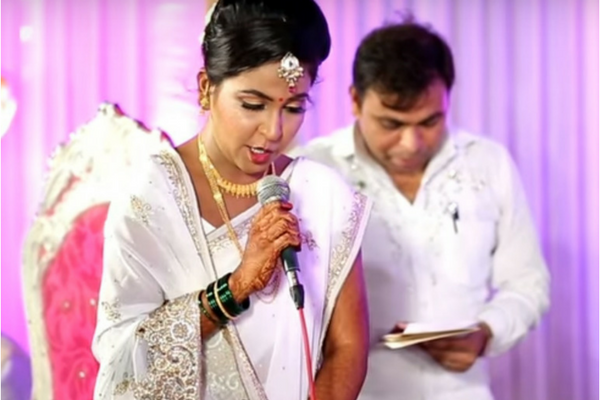
The bride and the groom are made to recite the Vandana, Tisarana and Pancasila which are a series of hymns in Pali language. They then recite the sacred vows for marriage from Sigilovda Sutta.![]()
“Towards my wife, I undertake to love and respect her, be kind and considerate, be faithful, delegate domestic management, provide gifts to please her.”
“Towards my husband, I undertake to perform my household duties efficiently, be hospitable to my in-laws and friends of my husband, be faithful, protect and invest our earnings, discharge my responsibilities lovingly and conscientiously.“![]()
Local language versions of the wedding vows may be used depending on the geography and culture. Rings and garlands may also be exchanged after the wedding vows are recited.
In Japan, Buddhist weddings are solemn affairs devoid of fanfare.
The ceremony starts with an offering of incense to Buddha and the priest then offers holy water to the couple. The bride and the groom then drink sacred rice wine from three separate cups meant to denote the three jewels of Buddhism – the Buddha, the Dharma and the Sangha.
The bride and the groom take three sips of the sacred rice wine from every cup and this ritual is called the “San – San – Kudo” to denote the 9 sips. The couple is then given the ojuzu or Buddhist prayer beads and finally, the couple is asked to exchange rings.
Did you know Buddhist monks in Japan are allowed to wed and have families? Read about this unique practice here.
Buddhist wedding dresses
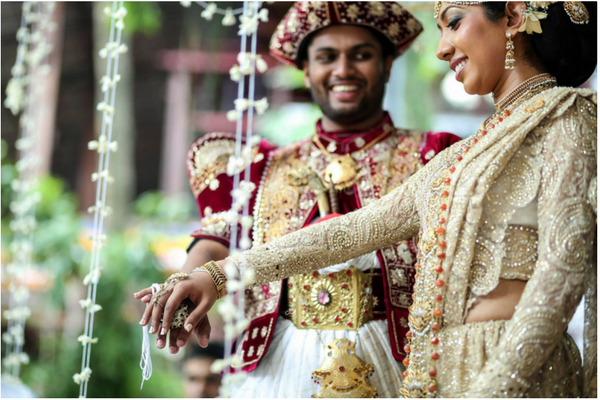
Wedding dresses in a Buddhist marriage are dictated more by cultural influences associated with geography than by the religion itself.
Traditional Buddhist weddings in places like Sri Lanka involves the bride wearing Osariya (Sari) which is usually a shade of white along with Nalalpata which is an ornament for the head (very similar to the headgear worn by South Indian brides) and pendants, karma band style jewellery, bangles and the works.
The Srilankan Buddhist bridegroom wears a traditional wedding attire called the Nilame. It consists of an elaborately embroidered hat and jacket with a vest along with a saree or South Indian Dhoti tied in a unique way.
Wedding dresses in Marathi Buddhist marriages are simple. The bride usually wears a white saree with some jewellery and the groom wears a white shirt.
Some Marathi Buddhist weddings are more elaborate with traditional Marathi wedding dresses. The groom wears the Marathi Dhoti – Kurta with flowers on the head and a Nehru cap.
In Thailand, the dressing style for Buddhist weddings is dictated by Thai traditions. Thai Dusit Style, Thai Siwalai Style, Thai Jakapatdi Style are some of the different ways Thai brides dress up for the wedding. These are usually a two-piece material with a folded front and a wrap-around top. Each style has different ways the material is folded and tucked.

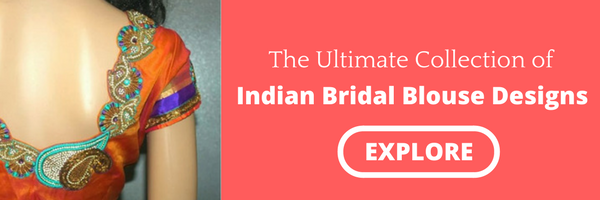
Thai bridegroom wears a suit but the trousers are replaced with an Indian Dhoti style cloth and matching socks. Once again there are variations depending on the region within Thailand.
Buddhist wedding food

Buddhist wedding food once again is dictated by geography and culture.
Marathi Buddhist weddings are no different from Marathi Hindu weddings. The size of the spread boils down to the choices made by the family. They either keep it simple or organise a lavish feast. Typical Marathi Buddhist wedding feast items include Batata Vada, Bhajjis (vegetable fritters), stuffed brinjal (Bharli Vaangi), Batatachyi Bhajji with puris, vegetable pulao, Puran Poli and Shrikhand.
In places like Thailand, a Buddhist wedding menu might have items like Tom Kha Gai (Chicken and coconut soup), Yam Sam Klop (mango salad), Bplaa Pook Pad Pak Gadong (fish with sour cabbage), Kaeng Matsaman (Beef or chicken curry) and Nam Phrik Kapi Kap Pla Thu thot (shrimp based spicy dish).
Thai wedding dessert staples include Khanom Kareaw, Khanom Tuay Foo, and Met Khanoon. Each of these desserts symbolises the bond between the couple.
In Sri Lankan Buddhist weddings vegetarian and non-vegetarian dishes find a place. Egg hopper, Kothu Rotti, different types of side dishes called the Sambol, Ambul Thiyal (sour fish curry), crab dishes, Biryani, Chicken dishes, Indian bread, Dal, rice and meat curries are some of the perennial favourites for weddings.
For dessert, Watalappan (egg custard made with jaggery and coconut milk) and an assortment of baked goods are a definite must.
Read this next
